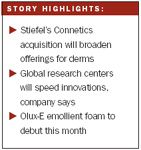- Case-Based Roundtable
- General Dermatology
- Eczema
- Chronic Hand Eczema
- Alopecia
- Aesthetics
- Vitiligo
- COVID-19
- Actinic Keratosis
- Precision Medicine and Biologics
- Rare Disease
- Wound Care
- Rosacea
- Psoriasis
- Psoriatic Arthritis
- Atopic Dermatitis
- Melasma
- NP and PA
- Skin Cancer
- Hidradenitis Suppurativa
- Drug Watch
- Pigmentary Disorders
- Acne
- Pediatric Dermatology
- Practice Management
- Prurigo Nodularis
- Buy-and-Bill
Article
Stiefel acquisition marries technology, marketing
Coral Gables, Fla. - Stiefel Laboratories' recent purchase of Connetics blends Connetics' innovative vehicle technology with Stiefel's worldwide marketing reach, company officials say. For dermatologists and patients, the acquisition augurs a steady stream of new applications for vehicles including the popular, patient-friendly foam pioneered by Connetics.

"Connetics very successfully spread the virtues of foam throughout the dermatology world. It's a vehicle that patients like a lot for several reasons," says Mark Lebwohl, M.D., professor and chairman, department of dermatology, Mount Sinai School of Medicine, New York.
For starters, he says, it's easy to see where the foam has been applied.

Announced in late October and closed Dec. 28, 2006, the acquisition not only broadens Stiefel's offerings for domestic dermatologists, but it also will give dermatologists outside the United States access to Connetics' technology, Mr. Humphries says.
Thanks to Stiefel's three global R&D centers - Research Triangle Park, N.C.; Maidenhead, England; and Bonsucesso-Guarulhos, São Paulo, Brazil - he adds, "Dermatologists will see a faster throughput" of innovations to the marketplace.

Another product using the emollient vehicle, Olux-E, approved for corticosteroid-responsive dermatoses such as psoriasis on Jan. 23, 2007, is slated to debut this month in 50-and 100-gram canisters, Mr. Humphries adds.
"One of the problems with foams is that they're a little drying," Dr. Lebwohl notes. Therefore, he says, "Having Olux-E in an emollient foam is a big advantage."
While the HF vehicle penetrates better and dissipates quickly, Mr. Humphries says, "The emollient vehicle works well for excoriated areas or areas that perhaps require more supple application."
Connetics' third foam formulation, water-based AF, can be tailored to the needs of the active molecule or patient, he adds.
Less well-known is Connetics' EPX (formerly called Liquipatch) delivery vehicle, Mr. Humphries says.
"That's a dispersion of the (active) molecule into a one-time application. We are looking at a number of ways to incorporate that" into future products, he says. The closest existing analog is Lamisil Once (terbinafine, Novartis), available in Europe under a licensing agreement for Connetics' foam technology.
Also in Stiefel's pipeline is Extina (2 percent ketoconazole foam).
Newsletter
Like what you’re reading? Subscribe to Dermatology Times for weekly updates on therapies, innovations, and real-world practice tips.






